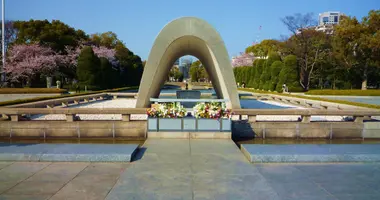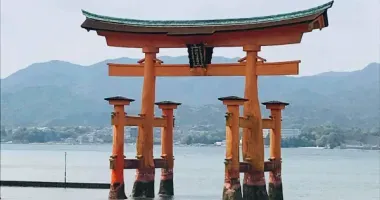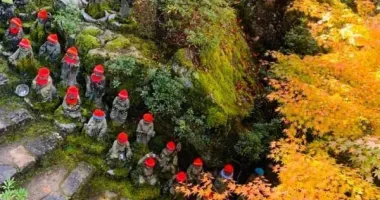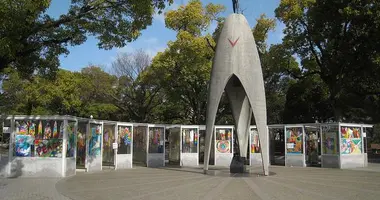Museum of Naval History Etajima
The Museum of Naval History is located on Etajima Island in Hiroshima Prefecture and is set among historic buildings on the campus of the First Service School of the Japan Maritime Self-Defense Force.
First Service School Japan Maritime Self-Defense Force Etajima 海軍兵学校
- Tour
- Access
- Hiroshima Museums
- Japan Museums
 Ceremonial Hall, The Museum of Naval History, Hiroshima Prefecture
Ceremonial Hall, The Museum of Naval History, Hiroshima Prefecture
The Museum of Naval History in Etajima, Hiroshima Prefecture is located inside a Japan Maritime Self-Defense Force base, which serves as an Officer Cadet School.
A visit to the Museum of Naval History includes a tour of the buildings of the former Imperial Japanese Naval Academy, which was established in Etajima in 1888. The museum itself was constructed in 1936 using donations from former Naval Academy graduates "in order to preserve the history and traditions of the Imperial Japanese navy."
The museum was closed in 1945 at the end of World War II and many of its documents destroyed to prevent them falling into enemy hands but the museum was reopened and restored in the 1950's.
 Ceremonial Hall Interior, The Museum of Naval History, Hiroshima Prefecture
Ceremonial Hall Interior, The Museum of Naval History, Hiroshima Prefecture  Shell from the Battleship Yamato and submarine, The Museum of Naval History, Hiroshima Prefecture
Shell from the Battleship Yamato and submarine, The Museum of Naval History, Hiroshima Prefecture
Tour
The tour first takes in the granite Daikodo (大講堂; Large Auditorium or Ceremonial Hall) where graduates of the school still receive their certificates of graduation and where entrance ceremonies are held. The white, plaster-ceiling interior has something of the solemnity of a shrine and is delicately lit from numerous windows. The wooden stage is decorated with the Hinomaru Rising Sun flag and Naval Ensign flag, the flag now flown by the JMSDF.
Next the tour passes past the elegant, brick Naval Academy building which was built with thousands of bricks imported from Britain, the foreign nation that helped Japan the most to establish a modern navy from the Meiji Period onwards. There is a photo stop at a narrow entrance leading into a courtyard which is often used in movies and TV dramas, but the tour does not enter the academy proper. The building was designed by a British architect in 1893 and is still used for classrooms and living quarters.
Next visitors pass to the classical, granite Naval Museum. On our tour we were asked to remove our hats, pause and bow on entry. No photography is allowed inside. The museum is located on the second floor after ascending a large, formal staircase.
Arranged chronologically, the museum has artefacts, documents, uniforms, paintings, weapons and photographs from the early beginnings of the Japanese navy starting with Ryoma Sakamoto and the kaientai in Nagasaki and Katsu Kaishu one of the founding fathers of the Tokugawa navy. There are further exhibits on the Sino-Japanese War of 1894-1895, the Russo-Japanese War from 1904-1905, World War I when Japan fought with the Allies against the Kaiser's Germany, Pearl Harbor and the Pacific War until the end of World War II.
There is much focus on Admiral Heihachiro Togo, Commander-in-Chief of the Japanese fleet during the Russo-Japanese War. Japan's "Nelson" is celebrated in a Bronze Relief Door containing a lock of his hair and showing eight scenes related to the decisive Battle of Tsushima.
Various heroes of the Japanese navy in the early 20th century are honored: Commanding Officer Takeo Hirose, who lost his life at Port Arthur in 1905 searching for one of his men and Lieutenant Tsutomu Sakuma, who went down with all his crew in an early Japanese submarine in 1910. His last statement while waiting for death at the bottom of the sea reads: "Every member of the crew bravely did his duty until death without rushing to the ladder to escape."
The latter part of the tour which included World War II was not narrated by the guide (possibly in deference to a Western visitor). It includes the exploits of Admiral Isoroku Yamamoto, the Commander-in-Chief of the Combined Fleet at Pearl Harbor, the Battle of Midway, the first Kamikaze Special Attack Force flight from an air base at Mabaracat in the Philippines. The English pamphlet drily notes: "The number of deaths attributed to Kamikaze attacks amounted to 2,525."
There are exhibits on the Kaiten (Human Torpedo) suicide submarine, a one-man sub packed with 1.6 tons of explosive. The English pamphlet reads: "The number of deaths attributed to the Kaiten total 96 including 16 accidental deaths during training."
Outside in the grounds is a shell from the Battleship Yamato weighing approximately 1,500 kg and one of the five midget submarines that took part in the attack on Pearl Harbor. It was discovered in 1961 in the ocean off Hawaii and brought back to Japan in 1962. Look out for the large gun turret and a shell from a Mutsu class battleship of the 1930's.
Also on the grounds is the Officers' Club, the oldest building on campus dating from 1888. The wooden, Japanese-style Residence of Price Takamatsu was built in 1920 for when the royal served in the Imperial Navy.
The waiting room for the tour includes a shop selling JMSDF goods and memorabilia including their own bottled beer. The restaurant serves a navy curry.
 Red Brick Students Hall, The Museum of Naval History, Etajima, Hiroshima
Red Brick Students Hall, The Museum of Naval History, Etajima, Hiroshima  Red Brick Students Hall, The Museum of Naval History, Hiroshima Prefecture
Red Brick Students Hall, The Museum of Naval History, Hiroshima Prefecture
Access - how to get to the Museum of Naval History, Etajima, Hiroshima
Museum of Naval History (http://www.mod.go.jp/msdf/onemss)
JMSDF First Service School, Aki-gun, Etajima
Hiroshima Prefecture 737-2195
Tel: 0823 42 1211
Admission: Free
Hours: There are tours lasting 90 minutes on weekdays at 10.30 am, 1 pm and 3 pm and on weekends and public holidays at 10 am, 11 am, 1 pm and 3 pm.
The Museum of Naval History is a short bus ride from Koyo Port ferry terminal. There are frequent sailings from Koyo Port to Hiroshima Port (Ujina) and Kure Port.
Note: *visitors should dress appropriately - no shorts allowed.
Other places of interest in Hiroshima include Hiroshima Castle, the Mazda Museum, the JMSDF Kure Museum, Hiroshima Museum of Art , Nagato Museum Of Shipbuilding History and Hiroshima Children's Museum.
 The Museum of Naval History, Etajima
The Museum of Naval History, Etajima Museum of Naval History, Etajima
Museum of Naval History, Etajima
Book Hotel Accommodation in Hiroshima
 Midget submarine from Pearl Harbor and shell from the Battleship Yamato, Museum of Naval History, Etajima, Hiroshima
Midget submarine from Pearl Harbor and shell from the Battleship Yamato, Museum of Naval History, Etajima, Hiroshima




















